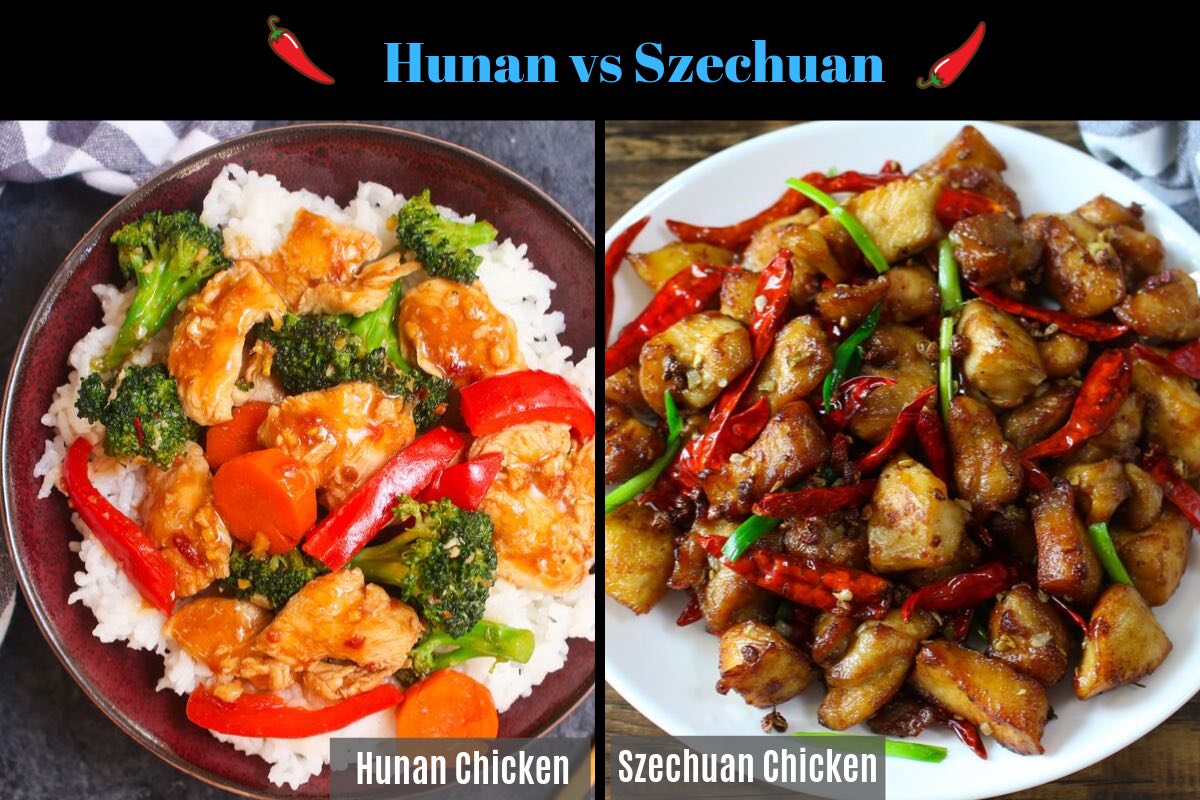Hunan Chicken Vs Szechuan Chicken
This post may contain affiliate links. Please read the disclosure policy.
Hunan Chicken vs Szechuan Chicken – explore the differences between these two popular Chinese main dishes! Whether you’re ordering takeout or making a spicy chicken stir-fry at home, learn about the spicy and delicious features of Hunan Chicken and Szechuan Chicken with this handy guide.

Hunan Chicken vs Szechuan Chicken: why the confusion?
There are many spicy Chinese chicken dishes, including General Tso’s Chicken, Kung Pao Beef and Mongolian Chicken. While it can be difficult to distinguish them all, Hunan chicken and Szechuan chicken cause the most confusion.
Why? Both Hunan and Szechuan are Chinese provinces, both cuisines are spicy and salty, and both Hunan and Szechuan chicken are traditionally served with steamed rice. What makes it more confusing is that Hunan chicken uses the spicy chili bean paste doubanjiang (辣豆瓣酱), which is the soul of Szechuan cooking. It’s therefore somewhat of a fusion dish in spite of its signature flavors.
The Difference Between Hunan and Szechuan Chicken
There are 7 factors distinguishing the two: the taste, ingredients, cooking methods, sauce (or lack of), vegetables, calories, and origins. The chart below summarizes these differences:
| Hunan Chicken | Szechuan Chicken | |
| Taste | “Dry heat” flavor | Spicy with mouth-numbing sensation |
| Ingredients | Doubanjiang, oyster sauce, chicken broth, soy sauce, rice wine, garlic, ginger, sugar, veggies, etc. | Szechuan peppercorn, dried red chilis, green onions, garlic, ginger, salt, sugar etc. |
| Cooking method | Sliced chicken breast is marinated and par-cooked before being stir-fried | Cubed chicken thighs are battered and deep-fried before being stir-fried |
| Sauce | Hunan sauce | No sauce |
| Vegetables | Broccoli, carrots, bell peppers, zucchini, etc. | No veggies |
| Calories | 300 calories/serving | 640 calories/serving |
| Origin | Western Hunan / Xiang River region, and Dongting Lake | Szechuan province |
What is Hunan Chicken
Authentic Hunan Chicken is a spicy stir-fry dish with sliced chicken breast and mixed vegetables in a delicious Hunan sauce. A spicy chili bean paste is used to create salty and spicy flavors, making it highly irresistible!
This dish comes from Hunan province in the south-central part of China. Hunan cuisine (also called Xiang cuisine) is known for being very spicy and oily.
What is Szechuan Chicken
Authentic Szechuan Chicken (also known as Sichuan Chicken or Schezwan Chicken or in Chinese as 辣子鸡) is a stir fry of crispy chicken thigh meat mixed with dried red chili peppers, Szechuan peppercorns and other seasonings.
It hails from Szechuan province, a region in China’s interior famous for its spicy cuisine. Szechuan dishes are popular in China and around the world.


While both dishes are spicy and savory, Hunan chicken is known for its characteristic “dry heat” flavor, while Szechuan chicken has a fiery and mouth-numbing sensation. Hunan chicken also has a hint of tanginess while Szechuan chicken is sweeter.
Which Ingredients Add Heat to Each Dish
While both dishes are known for being very spicy, the flavor is achieved with different seasonings. Hunan chicken uses doubanjiang (chili bean paste), which creates an earthy, fiery flavor from its lengthy fermentation process.
In contrast, Szechuan chicken’s heat comes from Szechuan peppercorns and dried red chili peppers. The peppercorns introduce citrusy overtones and create a tingly numbness in the mouth, setting the stage for the fire of the chili peppers.


Different Cooking Techniques
For Hunan style, chicken breast is thinly sliced, marinated and par-cooked in hot oil (a process called velveting) before being stir-fried with vegetables.
For Szechuan style, chicken thighs are cubed, battered and deep-fried until crispy and brown. They’re then stir-fried with red chili peppers, Szechuan peppercorns, and other seasonings.


Sauce vs. no Sauce
Szechuan chicken has no sauce and is famous for its spicy and numbing sensation. On the other hand, Hunan chicken is coated with Hunan sauce that has spicy, savory, tangy and slightly sweet notes.
Vegetables (or not)
Hunan chicken contains stir-fried vegetables such as broccoli, carrots, bell peppers, mushrooms, and zucchini. Szechuan chicken has no veggies other than seasonings such as garlic, ginger and occasionally some green onion.


How to Make Hunan Chicken
- Marinate thinly sliced chicken breast in egg white, vinegar, soy sauce, and cornstarch.
- Make Hunan sauce by whisking together chili bean paste, chicken broth, soy sauce, oyster sauce, vinegar, sugar, and cornstarch.
- Par-cook the marinated chicken for about 3-4 minutes in a wok and set aside.
- Stir-fry vegetables.
- Add Hunan sauce.
- Add back the chicken and thicken the sauce.
- Toss to coat and serve on steamed rice.
How to Make Szechuan Chicken
- Marinate chicken thighs in a mixture of soy sauce, rice wine vinegar, cornstarch, green onions, and ginger.
- Deep fry the chicken until crispy and browned. Set aside.
- Add Szechuan peppercorn and dried red chili peppers to a wok with oil. Fry until fragrant.
- Stir-fry garlic, ginger and green onions.
- Add back the fried chicken thighs, season with salt and sugar. Stir fry to combine.
- Garnish with green onions and optional sesame seeds. Serve on steamed rice.
Which is Spicier?
Both dishes are quite fiery, with the amount of heat varying by restaurant or homemade preparations. However, Szechuan chicken has the added mouth-numbing and tingling that enhances the spicy flavors.
Which is Healthier?
Hunan chicken is a healthier option, as the chicken is stir-fried while Szechuan chicken has more calories due to the deep-frying process.
FAQ
Can I Substitute Hunan for Szechuan Chicken?
While Hunan and Szechuan Chicken are both spicy Chinese dishes, they have different flavor profiles. Hunan Chicken is known for its bold and smoky flavors, while Szechuan Chicken is known for its numbing spiciness.
You can always experiment with a fusion of the two cuisines, but note that the seasoning profiles are distinct and not necessarily complementary.
Which is Hotter: Hunan Chicken or Szechuan Chicken?
Szechuan Chicken is considered hotter than Hunan Chicken, although a lot depends on the preparation and amount of chilis used. Also, Szechuan cuisine creates a numbing sensation on the tongue, so you may not detect how spicy it is.
Is Hunan Chicken Sweet or Spicy?
Hunan Chicken is known for its spicy flavor, with a mix of fresh and dried chili peppers providing a bold and intense heat. The dish also typically includes ingredients like garlic, ginger and scallions for added flavor.
While Hunan Chicken is not traditionally sweet, some restaurants may add sugar or honey to balance out the spiciness.
What’s the Difference Between Kung Pao Chicken and Szechuan Chicken?
Kung Pao Chicken and Szechuan Chicken are both spicy dishes, but they have different flavor profiles. Kung Pao Chicken is known for its sweet and tangy flavor, with ingredients like soy sauce, vinegar, and sugar balancing out the spiciness. The dish also typically includes peanuts or cashews for added texture.
Szechuan Chicken, on the other hand, is known for its numbing spiciness and bold flavor. The dish typically includes ingredients like garlic, ginger and Sichuan peppercorns.
What’s the Difference Between Szechuan Chicken and General Tso’s Chicken?
Szechuan Chicken and General Tso’s Chicken are both popular Chinese dishes in Western cuisine, but they have different origins and flavor profiles. Szechuan Chicken hails from the Sichuan province in China and uses garlic, ginger, and Sichuan peppercorns for its signature spicy flavor.
General Tso’s Chicken, on the other hand, is a sweeter and less spicy American-Chinese dish. The dish typically includes ingredients like soy sauce, vinegar, sugar, and chili peppers for its flavor.
More Chinese Chicken Dishes You May Like:
How to Make Hunan Chicken and Szechuan Chicken
Ingredients
Hunan Chicken:
- 1 pound chicken breasts, boneless/skinless, thinly sliced
- 3 tablespoons rice wine vinegar, divided
- 2 1/2 tablespoons soy sauce, divided
- 1 egg white
- 5 teaspoons cornstarch, divided
- 2 tablespoons vegetable oil, divided
- 2 teaspoons spicy doubanjiang, chili bean paste
- 1/2 cup chicken broth
- 2 tablespoons oyster sauce
- 1 teaspoon sugar
- 1 tablespoon minced garlic, (3 cloves)
- 1/2 tablespoon minced ginger
- 3 cups broccoli florets
- 1/2 red bell pepper, sliced
- 1 carrot, sliced
Szechuan Chicken:
- 1 1/2 pounds chicken thighs, boneless and skinless, cut to 1-inch cubes
- 2 tablespoons soy sauce
- 1 tablespoon rice wine vinegar
- 1 tablespoon cornstarch
- 2 stalks green onions, chopped and divided
- 3 slices ginger
- Vegetable oil, as needed for frying and stir-frying
- 1 1/2 tablespoons Szechuan peppercorns, whole
- 15 dried red chili peppers, cut into halves
- 1 tablespoon minced garlic, (3 cloves)
- 1 tablespoon minced ginger
- 1/2 teaspoon salt, or to taste
- 1/2 teaspoon sugar
Instructions
Hunan Chicken:
- In a medium bowl, mix rice vinegar, cornstarch and soy sauce (1 tablespoon each). Then add egg white and mix well.
- Add the sliced chicken and toss several times to coat. Cover and marinate for 20 minutes in the fridge.
- In a medium bowl, add the remaining vinegar, soy sauce, and cornstarch together with chicken broth, oyster sauce, and sugar. Whisk until the cornstarch dissolves. Set aside.
- Place a wok or large pan over medium-high heat and add 1 tablespoon oil.
- When hot, add the marinated chicken and fry for 3-4 minutes until the edges are lightly browned. Remove from the pan and set aside.
- Lower the heat to medium. In the same wok/pan, add remaining oil. Stir in garlic and ginger and fry for 30 seconds or until fragrant.
- Add broccoli, carrots, and red bell pepper. Stir fry for about 3 minutes until barely tender.
- Give the prepared sauce a quick stir and pour into the pan.
- Add back the par-cooked chicken and bring the sauce to a boil while stirring.
- Stir fry until the chicken is evenly coated and the sauce has thickened (about 2-3 minutes) and serve immediately with rice.
Szechuan Chicken:
- In a medium bowl, add soy sauce, rice wine vinegar, cornstarch, 1 stalk of chopped green onions, and ginger slices. Mix well.
- Add in the chicken pieces, and toss several times to coat. Cover and marinate for 10-15 minutes.
- Set aside a paper-towel lined plate.
- Place a large pot over medium-high heat. Add in about 2-inch (5cm) oil.
- When the oil is heated to about 350˚F (177˚C), use kitchen tongs to take the chicken pieces from the batter and add to the oil. Fry the chicken for about 3-5 minutes until browned and crispy. (Don’t overcrowd the pot. Fry in batches if needed.)
- Using a slotted spoon, remove chicken to a prepared plate.
- Add oil in a wok/pan with medium heat.
- Toast Szechuan peppercorn and dried red chilies in hot oil. Fry until fragrant, about 1 minute.
- Add in garlic, ginger and the remaining green onions. Stir fry for about 1 minute.
- Add in the cooked chicken, salt and sugar.
- Toss until combined and remove from heat.
- Garnish with optional green onions or sesame seeds. Serve with rice or noodles and enjoy! (avoid biting into whole Szechuan peppercorn as they are for flavoring only)
Equipment
Notes
- Both recipes yield medium level spiciness. You can adjust the heat to suit by adding more or less spicy ingredients.
- These dishes can be cooked ahead of time and reheated in a skillet or microwave for 3-4 minutes. Store in an airtight container in the fridge for up to 3 days.
Please read our nutrition disclaimer.
© TIPBUZZ. Images and text on this website are copyright protected. Please do not post or republish without permission. If you want to republish this recipe, please link back to this post. This post may contain affiliate links. Read the disclosure policy here.








Super delicious. Definitely tongue tingling.
Hi Heba, Great to hear and thanks for your feedback! Hope you’ll try more recipes on our site…
I love spicy chicken and got mixed up at restaurants and besides some are not authentic anyway. So I made both of these to let my family decide… they were both good but my husband like Hunan better lol. tysm, I can’t wait to make it again!
Hi Lisa, That’s amazing, congrats! Thanks for your comment and glad you enjoyed!